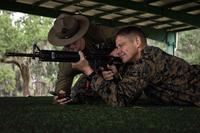The Air Force is set to discard 21 C-27Js before the end of fiscal year 2013, yet service officials still issued a request to industry on May 10 for proposals to purchase even more of the same exact aircraft that will likely sit in the boneyard.
The C-27J Spartan is the cargo aircraft that has found itself in the middle of a battle between the Air Force's active duty and the Air National Guard. Active duty leaders have said the service likes the aircraft, but can't afford it with the forthcoming budget cuts. Guard leaders have responded saying the aircraft will save the service money and the Guard, which was set to receive the bulk of the fleet, is being unfairly targeted to absorb the brunt of the service's budget cuts.
Congress has for the most part taken the Guard's side in the debate. Lawmakers have ordered the service to consider buying more C-27Js even though the service is set to follow through on plans to send the C-27J fleet to the service's boneyard at Davis Monthan Air Force Base, Ariz., with the 309th Aerospace Maintenance And Regeneration Group. There the aircraft will sit in storage unless another federal agency claims them.
The original plan was to field a fleet of 38 C-27Js across the service as part of the Joint Cargo Aircraft Program. Already, the Air Force has 15 C-27Js stationed at Guard bases and another two at Waco, Texas, at a L-3 Communications plant. Four more are on the books to be built by Alenia Aermacchi in Italy and sent to the U.S. in fiscal year 2013. Those newly built aircraft will likely be sent directly to the boneyard.
The Air Force spent about $1.6 billion to purchase the 21 aircraft. Soon after the first C-27Js arrived in Afghanistan in 2011 to start resupplying deployed Army units, the Air Force said it could no longer afford the luxury of the aircraft.
Air Force leaders had said the sustainment costs were too expensive to keep the C-27J when compared to the C-130. Former Air Force Chief of Staff Gen. Norton Schwartz told Congress in 2012 it cost $9,000 per hour to fly the C-27J and $10,400 to fly the C-130. Even though the C-130 was slightly higher per hour, the C-130 is well established within the fleet and the Air Force couldn't afford to introduce and sustain the C-27J.
"In response to a requirement in the FY12 NDAA to perform a cost-benefit comparison of the C-27J and C-130, the AF performed an exhaustive analysis which included a direct comparison of cost, capability and capacity of like-sized C-130 and C-27J units," Ann Stefanek, an Air Force spokeswoman, said. "The results of this analysis clearly demonstrated a lower life-cycle cost for the C-130 versus the C-27J."
The Ohio Air National Guard, which is one of four Guard units that fly the C-27J, had cost estimates of their own. Officials with the Ohio Guard said it cost $2,100 per hour to fly the C-27J and $7,000 per hour to fly the C-130.
Congress ordered the Air Force within the 2013 National Defense Authorization Act to form a working group and add 32 strategic airlifters. Lawmakers did not specify that those airlifters be C-27Js and Air Force Secretary Michael Donley said it's unlikely the service will keep the Spartan fleet alive.
However, the request issued on May 10 appears to be an attempt by service officials to show Congress that the service considered buying more C-27Js. Stefanek issued a statement in response to questions from Military.com.
"The Mobility Directorate (AFLCMC/WL) is contemplating procurement of C-27J aircraft, in accordance with Congressional language that states 'the Secretary of the Air Force shall obligate and expend funds previously appropriated for the procurement of C-27J Spartan aircraft for the purposes for which such funds were originally appropriated,'" Stefanek wrote in an email to Military.com.
Notably, the request from the Mobility Directorate stated the Air Force would not "reimburse participants for any information or expenses associated with their participation in this survey." The Sources Sought Synopsis stated that the Air Force Life-Cycle Management Center is "conducting market research to identify potential sources that possess the expertise, capabilities, and experience to manufacture and deliver C-27J aircraft."
Meanwhile, airmen continue work to transport the first 21 C-27J Spartans to the boneyard.







